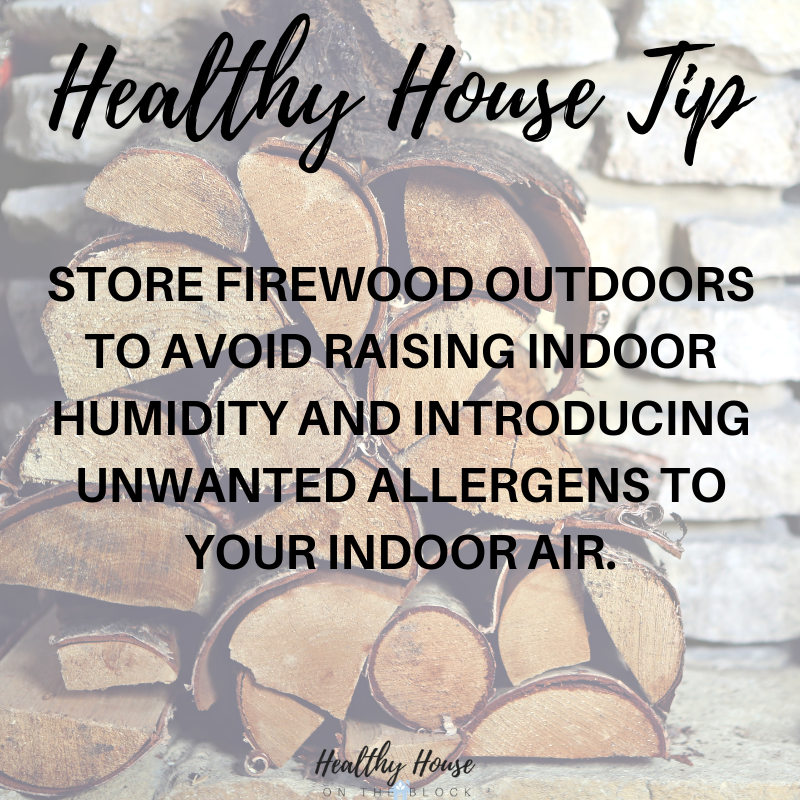
This week’s cooler temperatures and darker evenings had my kids asking when we could have a fire in the fireplace. And I realized it certainly is that time of year when we get to enjoy the warmth of the cozy fire.But fireplaces can become hazardous very quickly without the proper maintenance and ignored repairs. The use of any kind of fireplace can potentially introduce contaminants into your air that lower the indoor air quality if you’re not careful. Not only are there fire hazards, but toxins from burning materials can enter your air quickly and stick around long after your fire has been extinguished. And this doesn’t just go for wood burning fireplaces. Gas burning fireplaces have potential concerns and problems as well due to their use of natural gas and the fact that they produce combustion air. Knowing what to check at your own home can save you not only money in repair costs, but can prevent poor indoor air quality.
I like to show my clients just want to be aware of when it comes time to use their fireplace, and today I’m sharing those things to watch for with you.

ConvertKit Form
Wood Burning Fireplaces
The hearth is the area directly underneath your fireplace — often times where you place the wood. All hearth areas should be made of concrete or masonry. In other words, you don’t want a material that easily catches fire to be a component of your hearth area.
Hearth Extension
This is the area directly in front of your fireplace. Often times this consists of brick, concrete or even tile. If your home has had renovations performed at some point, this extension may have been changed and could be too small. You’ll want to check to make sure the depth of the hearth extension is 16″ – 20″.
Combustible materials should be kept at least 3 feet away from the fireplace opening.
Firebox
The firebox is the interior of your fireplace — the area you can see. The firebox wraps around the three “walls” within the fireplace and is often made of solid brick or a manufactured brick liner. Shining a flashlight inside the firebox will help you notice if there are any cracks. Cracking within the firebox will only get worse if it’s already started. Simple repairs can be made when a crack is in the beginning stages.
Another place you can check is the corners within the firebox if it is made of a pre-fabricated lining as opposed to solid brick. These corners should have no gaps in them and be completely sealed at the corners and joints.
Damper
Here’s where homeowners usually turn to a professional, but I promise you, any homeowner can look up the chimney to see their damper. If it’s too intimidating, simply take your phone and grab a picture of the damper both open and closed and visually inspect it from the picture.
First, make sure that your damper can be opened and closed with normal force. You’ll also want to make sure that when you open the damper door, it stays open. You can either grab a picture or peek in yourself. Next you’ll want to make sure when it’s closed, it’s fully closed.
Remember, always have the damper door completely open when you start a fire in your fireplace.
Flue Lining
You don’t necessarily have to climb up on your roof to inspect the flue of your home, but it can really help if you have an accessible roof. When you have your damper door open, look up into the chimney to view the flue. You should not see any white built up on the inside of the walls. This white build up is creosote and is highly flammable. This is precisely what chimney sweeps are cleaning out of chimneys.
If you see white build up, you’ll want to call someone out to clean your chimney. At that time they can also verify that the white build up is not efflorescence, which is due to moisture affecting the brick or clay of the flue.
Chimneys should be cleaned out every 1-2 years depending on how heavily they are used.
Doors
If your fireplace has doors, you’ll want to make sure that they close and seal properly. You’ll want to look for evidence of smoke around the doors and mantel. If you see soot and smoke stains, chances are the door has a leak of some kind.
Some doors become stained and can easily be cleaned off with some vinegar and water. You’ll want to avoid using any flammable cleaners on the door surfaces.
Exterior Chimney
If you choose to inspect your chimney, you’ll need to know what to look for. Any deteriorating bricks or mortar should be repaired as soon as it’s noticed. You’ll also want to check around the base of where your chimney meets your roof to ensure there’s no open spots where water can leak in. Often there is flashing, or a metal material around the base of the chimney, ensure water is routed away from the base and down the roof.
Getting a chimney inspection every now and then is well worth the money. Especially if you are in an older home. Older chimneys require a bit more attention to maintain. This maintenance and diligent checking can prevent bigger problems from occurring or fires from starting in the chimney or home.
Gas Fireplaces
Gas fireplaces require much less as far as maintenance go, but require the same amount of diligence when it comes to the health and safety of your home.Interior Inspection
Often the front part of the grill comes off of a gas fireplace allowing you to view the internal electrical and gas lines. This area should be kept as clean as possible, and opening at least once a season to vacuum it out is ideal.
You’ll want to check to make sure you don’t smell any gas odor. You can also purchase a gas detector device from a hardware store or on Amazon for a more technical approach.
I highly recommend you keep a carbon monoxide detector or an indoor air quality monitor in the same room as your gas fireplace. Because the fireplace uses gas, it has what is called combustion air. This combustion air that exits your home through a vent contains carbon monixide. It’s important to know if carbon monoxide levels are high as they can be deadly. We have no way of detecting carbon monoxide ourselves as it is odorless and clear. This is why carbon monoxide detectors are so important.
You can also examine the glass cover of your fireplace. Often times they can become dirty or streaked from condensation. This is merely cosmetic and can be cleaned off with a simple mixture of vinegar and water. Again, you’ll want to avoid using a flammable cleaner on these doors.
Exterior Inspection
The next thing you’ll want to double check is the vent where your combustion air exits your home. Often times it isn’t too far away from your fireplace. If your gas fireplace was converted from a wood fireplace, or it’s an older home, your exhaust from the fireplace may run up the chimney through the roof. If the exhaust vent is on the roof, you may want a professional to inspect it for you.
If your fireplace exhausts out the side of the home through a vent, however, you can view it yourself. Make sure it’s not blocked by anything and also make sure it has a proper screen on it to prevent animals from making homes or storing food in the vent. A blocked vent can be deadly as it doesn’t allow the carbon monoxide to safely exit your home.
Wood Burning Stoves
Wood burning stoves follow similar rules as a wood burning fireplace. You’ll want to make sure that anything flammable is kept at a safe distance away from the stove. Usually this is around three feet. You’ll also want to keep combustible items away from the exhaust or flue that exits the home.You can check the venting to make sure there is no smoke escaping it and that all smoke from the wood fireplace is being safely sent outdoors.
You’ll also want to check the flue outside if it’s accessible to ensure that the vent is not blocked by plants, decking or that an animal has not filled it with debris.
Wood is the only product that should be burned in a wood stove. Never use coal in your wood burning stove as coal burns at a much higher temperature than wood, posing a fire hazard.
Make sure that ashes are disposed of with every fire and safely brought outdoors after cooling. When you’re using the stove, you’ll want to make sure that the damper door is open, just like a standard fireplace.
Finally, check periodically between the chimney and stove to ensure there is no creosote build up. If there is, you’ll want to have it cleaned and swept. And just as I mentioned with your wood burning fireplace, you’ll want to have it cleaned every 1-2 years, depending on how much it’s used.
Other Tips For Fireplace Season

Firewood
All firewood really should be stored outside. The moisture that firewood brings into your home is surprisingly high and can negatively impact your indoor air quality. Keeping wood dry and covered is also ideal. You never want to burn green or wet wood.
Smoke Detectors
Smoke detectors are highly recommended in any room with a fireplace. If you have a gas fireplace, I’d recommend a combination smoke detector/carbon monoxide detector. This will help keep you and your family safe while using your fireplace this winter. Also, check to make sure the batteries are fresh every 6 months or so.
Fire Extinguishers
Before you start using your fireplace for the year, make sure you know where your fire extinguisher is located as well as that it works. Being prepared is one of the best practices for preventing a disaster in your home.
Indoor Air Quality
Wood fires produce excess smoke and gas fires produce carbon monoxide. Both are unhealthy for our indoor air and can cause a decrease in indoor air quality. It’s extremely important to know that all smoke and carbon monoxide is being safely expelled outdoors. You can use a detector of some kind or an indoor air quality monitor to check the health of your indoor air.
Share this:
- Click to share on Facebook (Opens in new window) Facebook
- Click to share on LinkedIn (Opens in new window) LinkedIn
- Click to share on Reddit (Opens in new window) Reddit
- Click to share on Pinterest (Opens in new window) Pinterest
- Click to print (Opens in new window) Print
- Click to share on X (Opens in new window) X




